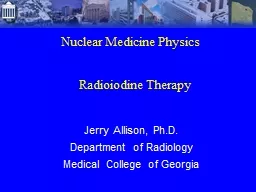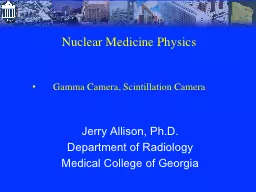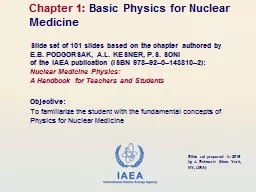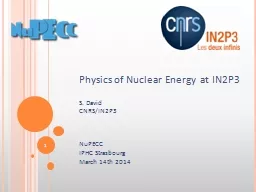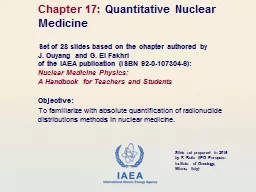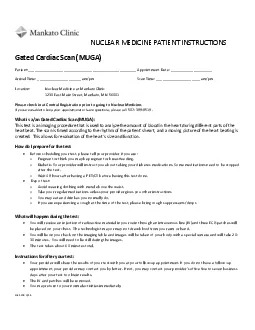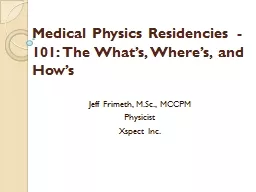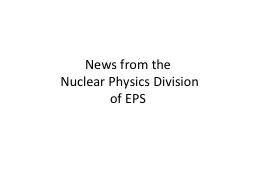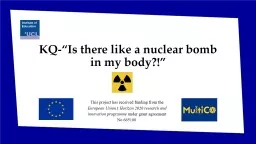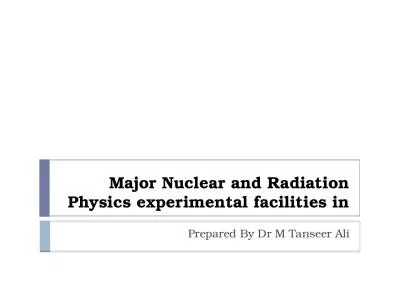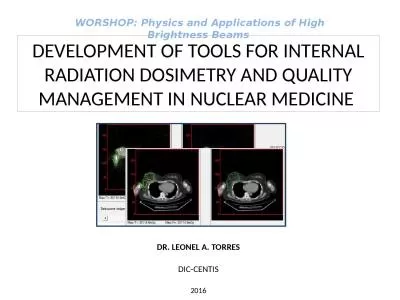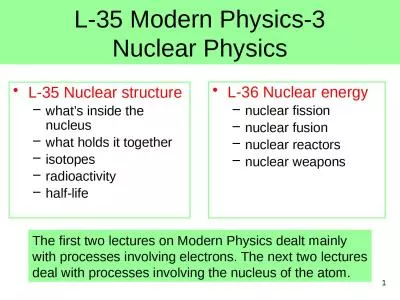PPT-Nuclear Medicine Physics
Author : jideborn | Published Date : 2020-06-17
Jerry Allison PhD Department of Radiology Medical College of Georgia Radioiodine Therapy A note of thanks to Z J Cao PhD Medical College of Georgia And Sameer
Presentation Embed Code
Download Presentation
Download Presentation The PPT/PDF document "Nuclear Medicine Physics" is the property of its rightful owner. Permission is granted to download and print the materials on this website for personal, non-commercial use only, and to display it on your personal computer provided you do not modify the materials and that you retain all copyright notices contained in the materials. By downloading content from our website, you accept the terms of this agreement.
Nuclear Medicine Physics: Transcript
Jerry Allison PhD Department of Radiology Medical College of Georgia Radioiodine Therapy A note of thanks to Z J Cao PhD Medical College of Georgia And Sameer Tipnis PhD G Donald Frey PhD. Jerry Allison, Ph.D.. Department of Radiology. Medical College of . Georgia. Radiation Detectors. A note of thanks to . Z. J. Cao, Ph.D.. Medical College of Georgia. And. Sameer . Tipnis. , Ph.D.. G. Donald Frey, Ph.D.. Jerry Allison, Ph.D.. Department of Radiology. Medical College of . Georgia. Gamma Camera, Scintillation Camera. A note of thanks to . Z. J. Cao, Ph.D.. Medical College of Georgia. And. Sameer . Tipnis. Xurong Chen . (for . Guoqing. Xiao). The Institute of Modern Physics. CAS, Lanzhou, China. 2015.8.3. Outline. Introduction. HIAF. ADS. Summary. 1. Introduction: Overview of IMP. The Institute of Modern Physics (IMP) was founded in 1957 in Lanzhou. As of 2014, there are 891 staffs and 296 postgraduate students studying for master or doctoral degree. for Nuclear Medicine. Slide set prepared in 2015. by J. Schwartz (New York, NY, USA). Slide . set of . 101 slides . based on the chapter authored by. E.B. PODGORSAK. , . A.L. KESNER. , . P.S. SONI. of . . at. IN2P3. S. David. CNRS/IN2P3. NuPECC. IPHC Strasbourg. March 14th 2014. 1. Nuclear. . physics. Nuclear. . data. System . studies. Scenarios . studies. Neutronic. . simulations. Experiment. Society. J. Ouyang and G. El . Fakhri. of the IAEA publication . (. ISBN 92-0-107304-6. ):. Nuclear Medicine Physics:. A Handbook for Teachers and Students. Objective. : . To . familiarize with . absolute . quantification . PATIENT INSTRUCTIONSGated Cardiac Scan MUGAPatientAppointment DateArrival Timeam/pmScan Timeam/pmLocationNuclear Medicine at Mankato Clinic1230 East Main Street Mankato MN 56001Please check in at Cent : The What’s, Where’s, and . How’s. Jeff . Frimeth. , M.Sc., MCCPM. Physicist. Xspect. Inc.. Outline. Autobiographical Sketch. Medical Physics – the what and the why. Medical Physics Residency Programs. of EPS. Last board meeting . October 23-24, 2017 . Bucharest IFIN-HH/ELI-NP . –. . miniworkshop. . e-EPS . –. November 2017. Change of chair . Nicola Bianchi . /. Italy . NPD presentation at Oslo . ?!”. This project has received funding from the . European Union’s Horizon 2020 research and innovation . programme. . under grant agreement No 665100. .. . KQ-“Is there like a nuclear bomb in my body?!”. Prepared By Dr M . Tanseer. Ali. Research Facilities. Bangladesh Atomic Energy Commission [BAEC]. Bangladesh Atomic Energy Commission (BAEC) was established in . 1973. as a multidisciplinary R&D organization with the view of promoting peaceful uses of nuclear energy in Bangladesh. . DR. LEONEL A. TORRES. DIC-CENTIS. 2016. WORSHOP: Physics . and Applications of High Brightness Beams . Specification, acceptance testing, quality control and maintenance of nuclear medicine equipment.. L-35 Nuclear structure. what’s inside the nucleus. what holds it together. isotopes. radioactivity. half-life. L-36 Nuclear energy. nuclear fission. nuclear fusion. nuclear reactors. nuclear weapons. Learn how to excel in AP Physics with this comprehensive guide. Explore essential concepts, study strategies, and resources to ace your AP Physics exam.
Download Document
Here is the link to download the presentation.
"Nuclear Medicine Physics"The content belongs to its owner. You may download and print it for personal use, without modification, and keep all copyright notices. By downloading, you agree to these terms.
Related Documents

